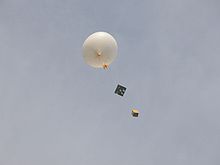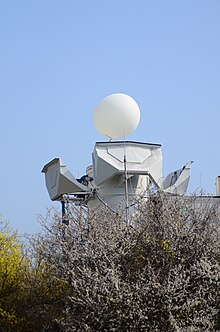Weather balloon
A weather balloon is a balloon that is used in meteorology to ascend measuring devices, especially radiosondes . The term weather balloon sometimes includes pilot balloons , as these also serve to - purely visual - determine weather phenomena, especially the wind direction at different heights and the height of the cloud base. It is also possible to track a balloon with a radar reflector and radar devices.
Types, sizes, structure
Weather balloons as well as pilot balloons are typically made of natural and / or synthetic rubber.
Molds for the dipping process come in two geometries:
- Paddle is flat, circular and, when filled, creates a slightly upright, lenticular ball. Two lighter, translucent lines appear on the circumference of the lens, reaching from the neck to the drip point (north pole of the filled balloon). The neck needs to be relatively wide to fit over the shape.
- Fluted is elongated, like a spindle, and has 4 or more grooves between the same number of meridional webs. The spherical shape is better achieved when filled, but by varying the material thickness between the web and groove, meridian stripes of different transparency become visible. The neck is less than half as wide as that of the paddle type, which saves material and makes it easier to close.
There are paddle-dipped balloons which, in a second production step, have a narrow latex filling attachment with about 1/5 the width of the neck "glued on".
Manufacturers are:
- Czermak & Feger in Imst , Tyrol (CF)
- The Weather Balloon Mfg. Co., Ltd. in Tokyo , Japan - Brand: KKS Cosmoprene (KKS)
Weather and pilot balloons are classified according to their mass.
In the past, pilot balloons tended to be released without equipment. Today it is possible to equip balloons with less payload with devices thanks to light and inexpensive LED lights, sensors and location systems with radio transmission. This blurs the functional separation of pilot and weather balloons. Today, weather balloons are also used to hobby film recordings up into the stratosphere.
Pilot balloons and weather balloons are classified according to their mass in grams: pilot balloons are available from 10 g, weather balloons up to 3000 g. As a rule, weather balloons are loaded with a load which corresponds to the weight of the balloon envelope. The filling is carried out with just enough helium gas that guarantees rapid ascent, but there is still plenty of room for expansion for the balloon, with the aim of reaching a great height at which the balloon ultimately bursts. This means that the balloon is only an obstacle to aviation for a short time - twice - and the distance between the landing site and the take-off site is kept compact - given the height of the space being targeted.
| Type, type designation |
Net weight / g |
Max. Supporting load / g |
Fill volume at ≈1 bar / m 3 |
Filling diameter at ≈1 bar / m |
Space transit knife / m |
Ascent speed / m / s |
Space height / km |
annotation | Manufacturer, data source |
|---|---|---|---|---|---|---|---|---|---|
| Pilot balloon | 10 | 10 | |||||||
| Pilot balloon P150 | 8th | 0.06 | approx. 0.45 | 8-10 | CF | ||||
| Pilot balloon P175 | 11 | 0.08 | approx. 0.55 | 8-10 | CF | ||||
| Pilot balloon P225 | 30th | approx. 0.70 | 12 | CF | |||||
| Pilot balloon P265 | 36 | 0.45 | approx 0.80 | CF | |||||
| Pilot balloon P350 | 50 | 0.90 | approx. 1.1 | 10-14 | CF | ||||
| Pilot balloon P450-100-SH | 100 | 2 | 1.5 | 20-30 | NATO, narrow filler neck | CF | |||
| Weather balloon | 200 | 200 | 0.5 | 0.5-0.7 | 5-7 | 23 | CF | ||
| Weather balloon | 800 | 800 | 2 | 1.4-1.6 | 5-7 | 30th | CF | ||
| Weather balloon | 1600 | 1600 | 4th | 1.9-2.1 | 5-7 | 36 | CF | ||
| Weather balloon | 2000 | 2000 | 5 | 2-2.2 | 5-7 | 38 | CF | ||
| Weather balloon | 3000 | 3000 | 6.3 | 2.3 | 13 | 5-7 | 40 | CF |
Typical mission sequence
A weather balloon is typically made of rubber and weighs only around 200 grams. The skin of the weather balloon is very sensitive and fine, so it may only be touched with protective gloves. Even minimal damage that has no consequences on the ground can lead to the balloon bursting prematurely at great heights with increasingly tense skin.
The balloon is usually filled with helium or hydrogen . In contrast to the rare and expensive helium, the latter is cheap and readily available; the problem of flammability is assessed as a manageable risk given the quantities required. The probe is attached to the weather balloon at a sufficient distance so that it does not rise in its slipstream. Since the balloon expands to a diameter of over twelve meters due to the air pressure decreasing with increasing altitude, the slipstream would greatly falsify the measurement results.
The weather balloon can easily reach a height of 38 km before it bursts and the probe parachutes back to the ground. (See: "Average height: 38,000m")
history
One of the first to use weather balloons was the French meteorologist Léon-Philippe Teisserenc de Bort . From 1896 he carried out over 200 balloon experiments, often at night, in order to rule out measurement errors due to radiant heat. The knowledge of the troposphere and stratosphere as layers of the earth's atmosphere comes from this time. Weather balloons are often used to explain alleged UFO sightings .
Weather balloons were previously filled with hydrogen, for which extremely careful safety precautions are required, but now usually with much more expensive, but non-flammable helium.
On April 1, 1970, a fatal happened Aircraft Accident : An Antonov An-24 B ( air vehicle registration CCCP-47751) of Aeroflot collided on Aeroflot Flight 1661 at 4:07 pm local time in 5400 m height with a weather balloon of the Meteorological Service , was on the nose damaged and crashed near Toguchin , Novosibirsk region ( Soviet Union ). All 45 inmates were killed.
literature
- Ingrid Kästner, Jürgen Kiefer (eds.): From comets, windpants, hailstorms and weather balloons. Contributions to the history of meteorology (= European Science Relations. Vol. 8). Shaker, Aachen 2014, ISBN 978-3-8440-3075-4 .
Web links
Individual evidence
- ↑ P450-100-SH with thin neck, NATO weather balloon / pilot balloon 100g + -5% ( memento of the original from September 11, 2017 in the Internet Archive ) Info: The archive link was inserted automatically and has not yet been checked. Please check the original and archive link according to the instructions and then remove this notice. ballonpoint.com, accessed September 11, 2017.
- ↑ Weather balloon tutorial: Start your own space mission stratoflights.com, accessed September 11, 2017.
- ↑ https://www.ballonpoint.com/de/latex-luftballons/wetterballons
- ↑ https://www.ballonpoint.com/de/latex-luftballons/wetterballons/p175-11-m-wetterballon-pilotenballon-11g-ballonfuellstutzen-standard-ausfuehrung-ballonfarben-wahl
- ↑ https://www.ballonpoint.com/de/latex-luftballons/wetterballons
- ↑ https://www.ballonpoint.com/de/p265-199-36-wetterballon-pilotballon-36g-ballonfuellstutzen-standard-ausfuehrung-ballonfarben-wahl?action_ms=1
- ↑ https://www.ballonpoint.com/de/p350-50-wetterballon-pilotballon-50g-ballonfuellstutzen-standard-ausfuehrung-ballonfarben-wahl-ohne-zubehoer?action_ms=1
- ↑ https://www.ballonpoint.com/de/p350-50-wetterballon-pilotballon-50g-ballonfuellstutzen-standard-ausfuehrung-ballonfarben-wahl-ohne-zubehoer?action_ms=1
- ↑ https://www.stratoflights.com/shop/wetterballon-200/
- ↑ https://www.stratoflights.com/shop/wetterballon-800/
- ↑ https://www.stratoflights.com/shop/wetterballon/
- ↑ https://www.stratoflights.com/shop/wetterballon-2000/
- ↑ https://www.stratoflights.com/shop/wetterballon-3000/
- ↑ https://www.stratoflights.com/shop/wetterballon-2000/
- ↑ Aircraft accident data and report CCCP-47751 in the Aviation Safety Network (English), accessed on February 13, 2017.


